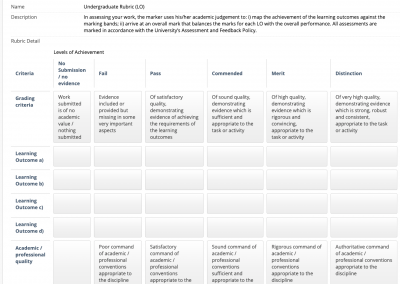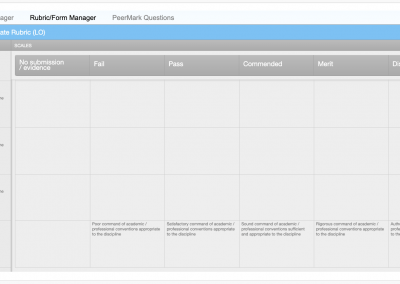1c) Supporting the deployment of learning technologies
Guidance
Statements about your involvement in supporting the deployment of learning technology might relate to providing technical and/or pedagogic support to teachers or learners, advising on (or redesigning to take account of) technical and usability issues, developing strategies or policies, managing change, providing training or other forms of professional development, securing or deploying dedicated funding and so on, all within the context of the educational use of learning technology. For evidence, you might include the overview section of a strategy document, meeting minutes, summaries of student feedback, testimonials or witness statements from other colleagues.
REVISIONS REQUIRED *The content in this portfolio area has been revised in response to feedback from CMALT assessors.
In the previous submission the message was confusing, and it was not clear that lessons had been learnt from mistakes in the project, this has been addressed in the new text.
Description
To show how I have supported the deployment of learning technologies I will be discussing my role in creating and deploying rubric templates for all staff at the University of Northampton, and facilitated the adoption of grading rubrics for all assessment feedback within the Faculty of Business and Law.
This was an eighteen month project which began in June 2018 when I was invited by the Head of Learning & Teaching Development Rachel Maxwell to investigate how using rubrics could help align student feedback to learning outcomes.
Working as a part of a small project development group I researched and advised on methods of deploying rubric templates within our VLE, and created new rubric templates for both Turnitin and Blackboard assignments which were introduced to all staff in September 2018.
These rubric templates were subsequently adopted by all staff in my subject area of FBL (Faculty of Business & Law) when faculty managers introduced the use of rubrics as essential feedback for all graded assignments.
Prior to this, academics in my faculty had graded student work in different ways, and few had adopted the use of rubrics.
My responsibilities in this project were:
- Researching the use of Turnitin and Blackboard rubrics.
- Consulting on workflows for all assignments using Rubrics.
- Working with colleagues on the deployment of site-wide rubric templates.
- Providing group training sessions to FBL staff on the use of Blackboard & Turnitin rubric templates.
- Designing training materials on the use of rubrics to grade all assignments.
- Providing one-to-one support with all faculty staff with design, deployment and marking of rubrics.
- Working to overcome technical issues.
Deploying the rubrics.
When exploring the use of rubrics I chose to follow an existing faculty specific workflow which advised staff to grade Turnitin assignments in the Blackboard grade centre.
This workflow was introduced a number of years before I began my support of the faculty and had been widely adopted by staff. I initially found this workflow confusing, however, upon testing this I found that adding rubrics to the Blackboard grade centre for all assignments had some benefits:
1. Staff would only need to use one type of rubric for all assignments, and as Blackboard rubrics were saved in the module they could be easily shared between tutors.
2. The rubric feedback was more accessible to students as it showed within the Blackboard the ‘Feedback & Grades’ area. – The Turnitin rubrics being four more clicks further for students to find.
3. The Blackboard rubrics could be weighted, and staff could add additional comments in the cells
4. Blackboard rubrics could be graded with a point range.
Having identified the benefits of using Blackboard rubrics I tested the workflow of adding a rubric in the grade centre many times, and found that this method of adding feedback was reliable.
Unfortunately, soon after introducing the use of Blackboard rubrics in the grade centre there was an upgrade to Blackboard Learn, after which staff began to report that the rubric content was being hidden from students when the second grader saved the rubric for a second time. Upon discovering these issues I reported this to Blackboard who identified that this was a bug.
Working with my Learning Technology manager – Robert Farmer, we promptly sent out communications explaining the issue with new guidance to grade Turnitin assignments using Turnitin.
To resolve the issue I worked with each tutor to double check all the student feedback was correctly released. I also arranged group and individual training with all faculty staff to implement the correct rubric and support them during their first year of using rubrics for feedback.
Reflection
Feelings – what were you thinking and feeling?
When asked to standardise the practice of grading using rubrics, I was concerned that this may be unpopular with academics who had established their own workflows for providing student feedback.
This feeling was not unfounded, however, by listening to their concerns, providing demonstrations and offering further 1:1 support throughout the year I sought to make every effort to help them adopt the use of rubrics.
The discovery that the method of using rubrics in the Blackboard Grade Centre was at fault was a set back to this project and also to my confidence.
To my surprise staff were very understanding and grateful for my support to resolve the issue, also my manager was supportive and complimentary on my efforts to rectify the problem.
In the end the problems were all resolved and a new workflow was put into place.
Evaluation – What was good and what was bad about the experience.
The decision by FBL managers to standardise feedback methods by adopting the use of rubrics, resulted in the need for widespread change. This was positive, as it meant that all staff were committed to this project.
As mentioned, the biggest challenge was discovering the bug which caused feedback to be hidden from students. However by discussing the issue with colleagues from the Learning Technology team I was able to quickly react to the problem and advise on a new workflow which allowed staff to do what they wanted to do using a slightly different method.
One of the interesting aspects of the project was that by focusing on what staff want to do, rather than the individual tools I have been able to help support a new method of providing feedback which is both robust and student centred.
Analysis – What sense can you make of the situation
A key impact of this project was that by designing rubrics which mapped assignments to learning outcomes – staff had an opportunity to reflect on their assessment methods. I think the academic staff found this process initially very challenging but ultimately rewarding as it prompted them to consider how they may improve the design of their assignments in the future.
Conclusion – What else could you have done?
I was relatively new to my LearnTech role and as the request to standarise grading was from within my faculty I was keen to prove I could lead a large project which had considerable impact at the University. In hindsight I think it was a mistake to undertake this on my own, and I should have sought to work with others from the Learning Technology team to investigate the deployment of rubrics for all staff and to establish a universal approach.
Action Plan – If it arose again what would I do?
If I was to begin this project again I would question the use of faculty specific workflows as these were difficult to support.
These have now been replaced by universal guidance for all staff on grading assignments. This is an improvement because it means that all of the LearnTech team members can now support all members of staff and the workflows are regularly checked and updated when necessary.
Evidence
Interview with head of FBL Post Graduate Studies Angela Rushton on faculty adoption of rubrics for feedback.
Rachel Maxwell - Head of Learning and Teaching Development: Policy and Practice
Following the University review of assessment, I worked with Richard to help implement the final stage of the process – marking to learning outcomes and supporting staff to use technology to do this effectively.
The Faculty of Business and Law decided to adopt one approach for the whole Faculty – the use of a detailed rubric that matched the grade criteria to the specifics of the learning outcome (or an aspect of a learning outcome).
Richard was able to work with the policy requirements and translate them into practice in such a way as to realise the objective. His approach was also transferable to colleagues in other Faculties as he developed a University-wide template rubric for marking to learning outcomes that has now been built into the template NILE sites for the coming year, across the institution.

